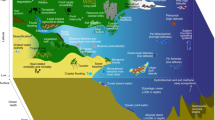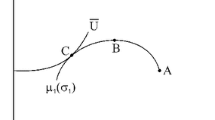Abstract
Evidence shows the global climate will continue to change over this century and beyond. A clear understanding of the climate change risk is suggested to be the foundation of the human adaptation. The plausible climate risk index reported by Germanwatch may be criticized as the fully compensatory assumption among underlying indicators, and the risk performance of each country in absolute terms cannot be assessed as the information on indicator level lost. We formulate an enhanced non-compensatory assessment scheme to reassess country’s risk performance under climate change by means of penalizing underlying indicators that fail to satisfy certain criteria. Based on the new scheme, we can genuinely restrict the compensability among underlying indicators and provide informative decision aiding. A case study is performed to illustrate the effectiveness of our analysis by constructing a new climate risk index for 119 countries in terms of death toll, deaths per 100,000 inhabitants, absolute losses in PPP and losses per GDP unit.





Similar content being viewed by others
References
Adenle AA, Ford JD, Morton J, Twomlow S, Alverson K, Cattaneo A, Cervigni R, Kurukulasuriya P, Huq S, Helfgott A, Ebinger JO (2017) Managing climate change risks in Africa—a global perspective. Ecol Econ 141:190–201
Alfieri L, Feyen L, Dottori F, Bianchi A (2015) Ensemble flood risk assessment in Europe under high end climate scenarios. Glob Environ Change 35:199–212
ASC (2016) UK climate change risk assessment 2017 synthesis report: priorities for the next five years. Adaptation Sub-Committee of the Committee on Climate Change, London
Athanassoglou S (2015) Revisiting worst-case DEA for composite indicators. Soc Indic Res 128(3):1259–1272
Attardi R, Cerreta M, Sannicandro V, Torre CM (2018) Non-compensatory composite indicators for the evaluation of urban planning policy: the Land-Use Policy Efficiency Index (LUPEI). Eur J Oper Res 264:491–507
Bandura R (2011) Composite indicators and rankings: inventory 2011 (unpublished paper)
Binita KC, Shepherd JM, Gaither CJ (2015) Climate change vulnerability assessment in Georgia. Appl Geogr 62:62–74
Bloomberg MR, Pavarina D, Pitkethly G, Thimann C, Sim YL (2017) Final report: Recommendations of the task force on climate-related financial disclosures
Böhringer C, Jochem PEP (2007) Measuring the immeasurable—a survey of sustainability indices. Ecol Econ 63:1–8
Carreño ML, Cardona OD, Barbat AH (2007) A disaster risk management performance index. Nat Hazards 41:1–20
Carter JG (2018) Urban climate change adaptation: exploring the implications of future land cover scenarios. Cities 77:73–80
Chen Y, Liu R, Barrett D, Gao L, Zhou M, Renzullo L, Emelyanova I (2015) A spatial assessment framework for evaluating flood risk under extreme climates. Sci Total Environ 538:512–523
Cherchye L, Kuosmanen T (2004) Benchmarking sustainable development: a synthetic meta-index approach. Research paper, UNU-WIDER, United Nations University
Cherchye L, Knox Lovell CA, Moesen W, Van Puyenbroeck T (2007a) One market, one number? A composite indicator assessment of EU internal market dynamics. Eur Econ Rev 51:749–779
Cherchye L, Moesen W, Rogge N, Puyenbroeck TV (2007b) An introduction to ‘benefit of the doubt’ composite indicators. Soc Indic Res 82:111–145
Cherchye L, Moesen W, Rogge N, Van Puyenbroeck T, Saisana M, Saltelli A, Liska R, Tarantola S (2008) Creating composite indicators with DEA and robustness analysis: the case of the Technology Achievement Index. J Oper Res Soc 59:239–251
Decancq K, Lugo MA (2013) Weights in multidimensional indices of wellbeing: an overview. Econ Rev 32:7–34
Despotis DK (2005a) Measuring human development via data envelopment analysis: the case of Asia and the Pacific. Omega 33:385–390
Despotis DK (2005b) A reassessment of the human development index via data envelopment analysis. J Oper Res Soc 56:969–980
Diaz-Balteiro L, Romero C (2004) In search of a natural systems sustainability index. Ecol Econ 49:401–405
Dilley M, Chen RS, Deichmann U, Lerner-Lam AL, Arnold M, Agwe J, Buys P, Kjevstad O, Lyon B, Yetman G (2005) Natural disaster hotspots: a global risk analysis (No. 34423). The World Bank, Washington
Eckstein D, Künzel V, Schäfer L (2017) Global Climate Risk Index 2018: who suffers most from extreme weather events? Weather-related loss events in 2016 and 1997 to 2016. Germanwatch e.V, Bonn
El-Zein A, Tonmoy FN (2015) Assessment of vulnerability to climate change using a multi-criteria outranking approach with application to heat stress in Sydney. Ecol Ind 48:207–217
Ewert F, Rötter RP, Bindi M, Webber H, Trnka M, Kersebaum KC, Olesen JE, van Ittersum MK, Janssen S, Rivington M, Semenov MA, Wallach D, Porter JR, Stewart D, Verhagen J, Gaiser T, Palosuo T, Tao F, Nendel C, Roggero PP, Bartošová L, Asseng S (2015) Crop modelling for integrated assessment of risk to food production from climate change. Environ Model Softw 72:287–303
Färe R, Grosskopf S, Pasurka Carl A (2010) Toxic releases: an environmental performance index for coal-fired power plants. Energy Econ 32:158–165
Ford JD, Keskitalo ECH, Smith T, Pearce T, Berrang-Ford L, Duerden F, Smit B (2010) Case study and analogue methodologies in climate change vulnerability research. Wiley Interdiscip Rev Clim Change 1:374–392
Fung CF, Lopez A, New M (2011) Modelling the impact of climate change on water resources. Wiley, Hoboken
Fusco E (2015) Enhancing non-compensatory composite indicators: a directional proposal. Eur J Oper Res 242:620–630
Gallina V, Torresan S, Critto A, Sperotto A, Glade T, Marcomini A (2016) A review of multi-risk methodologies for natural hazards: consequences and challenges for a climate change impact assessment. J Environ Manag 168:123–132
Greiving S, Zebisch M, Schneiderbauer S, Fleischhauer M, Lindner C, Lückenkötter J, Buth M, Kahlenborn W, Schauser I (2015) A consensus based vulnerability assessment to climate change in Germany. Int J Climate Change Strat Manag 7:306–326
Hahn MB, Riederer AM, Foster SO (2009) The Livelihood Vulnerability Index: a pragmatic approach to assessing risks from climate variability and change—a case study in Mozambique. Glob Environ Change 19:74–88
IPCC (2014) Climate change 2014: synthesis report. In: Core Writing Team, Pachauri RK, Meyer LA (eds) Contribution of working groups I, II and III to the fifth assessment report of the intergovernmental panel on climate change. IPCC, Geneva
Johnson K, Depietri Y, Breil M (2016) Multi-hazard risk assessment of two Hong Kong districts. Int J Disaster Risk Reduct 19:311–323
Jun K-S, Chung E-S, Kim Y-G, Kim Y (2013) A fuzzy multi-criteria approach to flood risk vulnerability in South Korea by considering climate change impacts. Expert Syst Appl 40:1003–1013
Keeney RL, Raiffa H (1993) Decisions with multiple objectives: preferences and value trade-offs. Cambridge University Press, Cambridge
Kunreuther H, Heal G, Allen M, Edenhofer O, Field CB, Yohe G (2013) Risk management and climate change. Nat Clim Change 3:447–450
Lantada N, Pujades LG, Barbat AH (2008) Vulnerability index and capacity spectrum based methods for urban seismic risk evaluation. A comparison. Nat Hazards 51:501
Munda G, Nardo M (2009) Noncompensatory/nonlinear composite indicators for ranking countries: a defensible setting. Appl Econ 41:1513–1523
New M, Liverman D, Anderson K (2009) Mind the gap. Nature reports climate change 143
Novelo-Casanova DA, Suarez G (2015) Estimation of the Risk Management Index (RMI) using statistical analysis. Nat Hazards 77:1501–1514
OECD/EU/JRC (2008) handbook on constructing composite indicators: methodology and user guide. OECD Publishing, Paris
OECD (2019) Composite leading indicator (CLI). https://doi.org/10.1787/4a174487-en
Ojoyi M, Mutanga O, Mwenge Kahinda J, Odindi J, Abdel-Rahman EM (2017) Scenario-based approach in dealing with climate change impacts in Central Tanzania. Futures 85:30–41
Rogge N (2018) Composite indicators as generalized benefit-of-the-doubt weighted averages. Eur J Oper Res 267:381–392
Ronco P, Zennaro F, Torresan S, Critto A, Santini M, Trabucco A, Zollo AL, Galluccio G, Marcomini A (2017) A risk assessment framework for irrigated agriculture under climate change. Adv Water Resour 110:562–578
Roy B, Figueira JR, Almeida-Dias J (2014) Discriminating thresholds as a tool to cope with imperfect knowledge in multiple criteria decision aiding: theoretical results and practical issues. Omega 43:9–20
Sperotto A, Molina J-L, Torresan S, Critto A, Marcomini A (2017) Reviewing Bayesian Networks potentials for climate change impacts assessment and management: a multi-risk perspective. J Environ Manag 202:320–331
Tofallis C (2013) An automatic-democratic approach to weight setting for the new human development index. J Popul Econ 26:1325–1345
Tonmoy FN, El-Zein A (2018) Vulnerability to sea level rise: a novel local-scale indicator-based assessment methodology and application to eight beaches in Shoalhaven, Australia. Ecol Ind 85:295–307
Tonmoy FN, Wainwright D, Verdon-Kidd DC, Rissik D (2018) An investigation of coastal climate change risk assessment practice in Australia. Environ Sci Policy 80:9–20
Torresan S, Critto A, Rizzi J, Zabeo A, Furlan E, Marcomini A (2016) DESYCO: a decision support system for the regional risk assessment of climate change impacts in coastal zones. Ocean Coast Manag 120:49–63
UNDP (2017) Human development report 2016: human development for everyone. United Nations, New York
USGCRP (2017) In: Wuebbles DJ, Fahey DW, Hibbard KA, Dokken DJ, Stewart BC, Maycock TK (eds) Climate science special report: fourth national climate assessment, vol I. U.S. Global Change Research Program, Washington, DC
Verbunt P, Rogge N (2018) Geometric composite indicators with compromise benefit-of-the-doubt weights. Eur J Oper Res 264:388–401
Yuan XC, Wei YM, Wang B, Mi Z (2017) Risk management of extreme events under climate change. J Clean Prod 166:1169–1174
Zanella A, Camanho AS, Dias TG (2015) Undesirable outputs and weighting schemes in composite indicators based on data envelopment analysis. Eur J Oper Res 245:517–530
Zhang LP, Zhou P (2018) A non-compensatory composite indicator approach to assessing low-carbon performance. Eur J Oper Res 270:352–361
Zhou P, Ang BW, Poh KL (2007) A mathematical programming approach to constructing composite indicators. Ecol Econ 62:291–297
Zhou P, Ang BW, Zhou DQ (2010) Weighting and aggregation in composite indicator construction: a multiplicative optimization approach. Soc Indic Res 96:169–181
Zhou P, Ang BW, Zhou DQ (2012) Measuring economy-wide energy efficiency performance: a parametric frontier approach. Appl Energy 90:196–200
Zhou P, Delmas MA, Kohli A (2017) Constructing meaningful environmental indices: a nonparametric frontier approach. J Environ Econ Manag 85:21–34
Acknowledgements
This work was supported by the National Natural Science Foundation of China (Nos. 71573119 and 71625005), the China Scholarship Council (No. 201703780115), China Postdoctoral Science Foundation (2017M611811) and the Funding of Jiangsu Innovation Program for Graduate Education (No. KYZZ16_0159).
Author information
Authors and Affiliations
Corresponding author
Additional information
Publisher's Note
Springer Nature remains neutral with regard to jurisdictional claims in published maps and institutional affiliations.
Rights and permissions
About this article
Cite this article
Zhang, L.P., Zhou, P. Reassessment of global climate risk: non-compensatory or compensatory?. Nat Hazards 95, 271–287 (2019). https://doi.org/10.1007/s11069-018-3558-7
Received:
Accepted:
Published:
Issue Date:
DOI: https://doi.org/10.1007/s11069-018-3558-7




